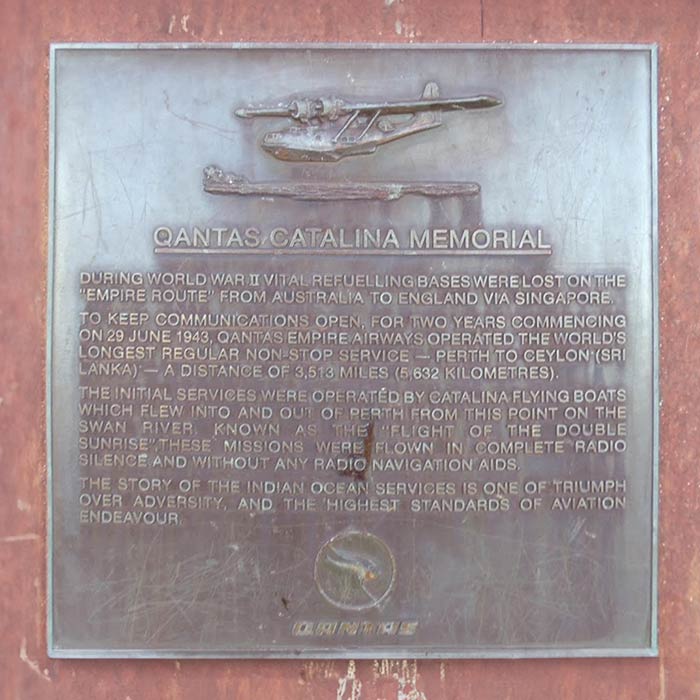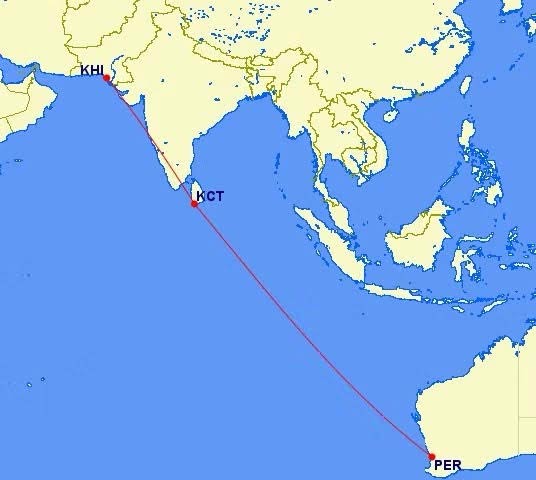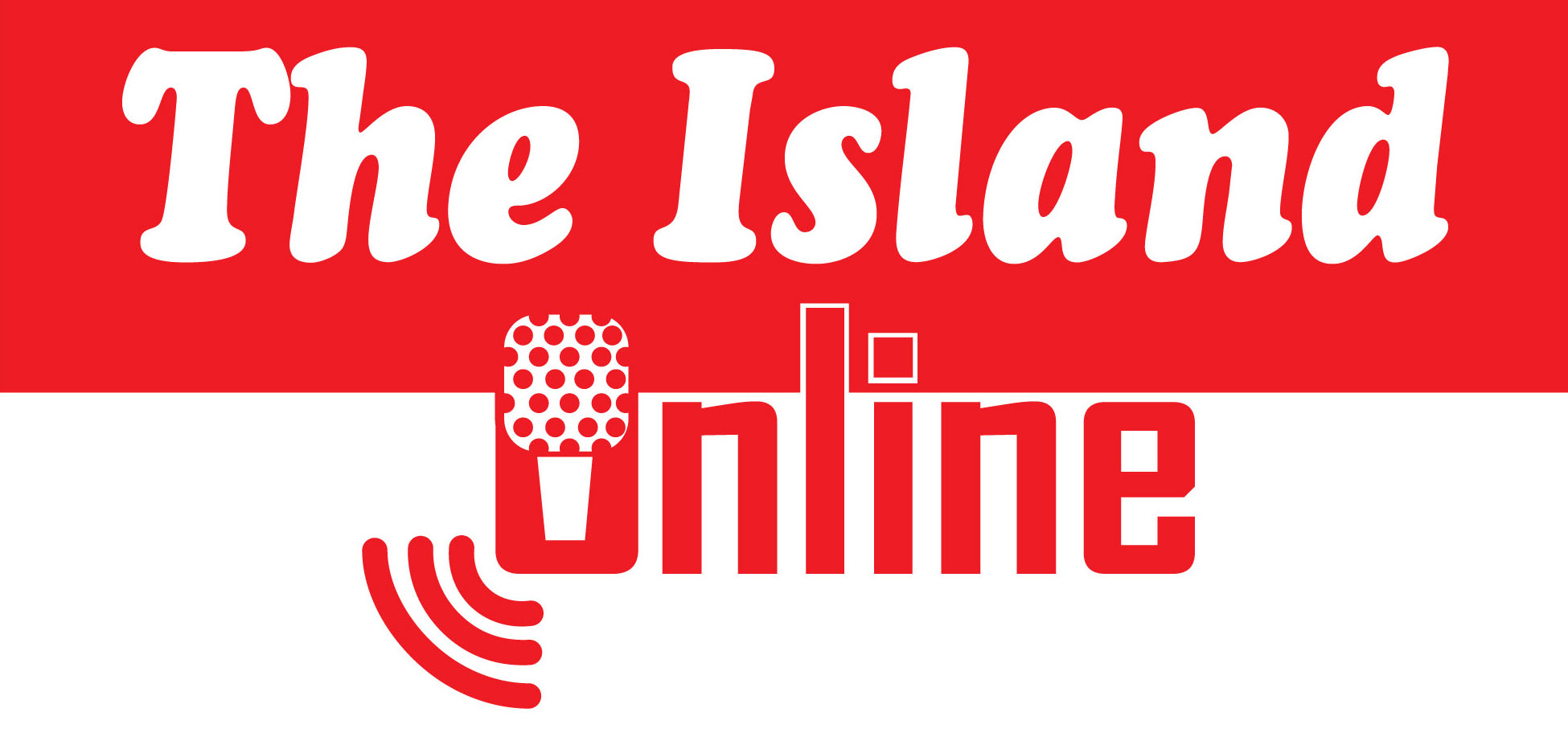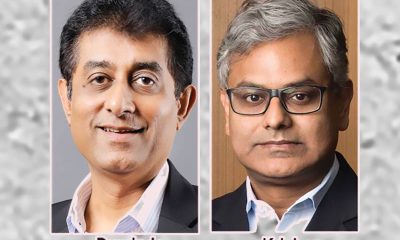Features
Lest such be forgotten – those who flew the Double Sunrise

The commercial record for aviation’s longest non-stop flight is 32 hours and nine minutes
BY Capt. Elmo Jayawardena
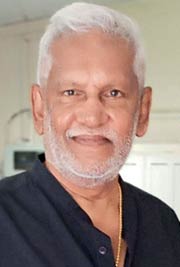 My memory fails me at times for dates, but I think this happened more than 40 years ago. Someone had visited my home in Moratuwa and left a parcel for me.
My memory fails me at times for dates, but I think this happened more than 40 years ago. Someone had visited my home in Moratuwa and left a parcel for me.
“Tell the Captain it is a special gift from me for the favor he did.”
I only opened the package a few days later. To my absolute astonishment the gift was a flight computer that was used by pilots and navigators during the Second World War. I had no clue as to who the generous donor was. He had said he came from Galle, and he had only come to Moratuwa to hand over the gift. The old computer had been in his home for a very long time, discarded and asleep, ignored by the householders who perhaps had no clue as to what this contraption was. Maybe someone thought this had something to do with flying? Maybe that is why the man from Galle brought it to me in return for something I had done for him.
In the picture here is the gift from Galle, an ancient flight computer that had flown in the skies giving all the calculations that helped the airmen of a long-gone era in their rudimentary navigational calculations. The fascination of it all was that the computer worked in perfect order with smoothly moving dials and pointers. This to me was straight from a treasure trove. On the back of the computer it was engraved that it was made in 1929. By the year 2029 this magnificent machine will be 100 years old. That is just five years away. Many a time I have taken this computer out and worked a triangle of velocities and come up with answers of ground speeds and drift angles, just for the heck of it. Its precision is perpetual, perfect even after all these years in Rip Van Winkle mode.
- Catalina memorial in Perth
- Double Sunrise certificate
As things stand now, I am wading in my twilight years and I walk under different skies with little to do with aviation. This old Galle computer and a very old wooden Tiger Moth propeller are all I have left from a long-lasted aviation career.
Of course, I carry aeroplane memories that are the incomparable luxuries of my life. More than enough to last me the rest of my days and to share some too, with others who love the sky.
Let me get back to the ‘gift’ computer story. I had the magic ancient path-finder and I knew it was found in some silent corner in a house in Galle. The question was how did it get there? In no time I homed in on a possible answer. Qantas Imperial Airways in the early 1940s flew a marathon non-stop flight from Perth to Koggala Lake and the crew had their layover in the New Oriental Hotel, the best then in Galle, which had been in existence from 1865. I assumed that my gifted flight computer would have been left in the flight bag of one of the pilots and found its way to a house in Galle. Let’s not squabble about how it got there. That is the nuclear part of the story.
Long before the computer fairytale from Galle, Qantas Imperial Airways flew from Sydney to London with multiple stops. It was the late 1930s and the trip so flown was called the Kangaroo Flight. This was a commercial passenger venture, also a major carrier of mail between two continents. The initial routing was Sydney, Perth, Singapore, Calcutta and Karachi onward to the Middle East and then to Europe.
At the onset of the Second World War the men from the ‘land of the rising sun’ marched out of the Japanese Islands to conquer Asia. Their Axis partner Germany was battering Europe. The Malayan peninsula fell to the Japanese and so did Singapore. The Kangaroo flight lost its ‘pit stop’ at Singapore to continue to Calcutta. The vitally important link between Sydney and London was lost with the Japanese occupation of Singapore. Qantas needed a replacement refueling stop between Perth and Calcutta. It had to be in British territory, safe from the Japanese fighter planes roaming the Asian skies. It also had to be within the range of the available Qantas aeroplanes which could fly non-stop from Perth to wherever Singapore ‘s replacement landing port was located.
This was ‘Rule Britannia’ time and other than the territories invaded by the Japanese, the rest of Asia belonged to the Colonial United Kingdom.
The Brits scouted and calculated every possibility. They were ‘world owners’ and had their imperial tentacles spread far and wide in most continents. In no time they found the perfect answer. Koggala Lake in the south of Ceylon, just 10 miles from the city of Galle. It was approximately 3,100 nautical miles as the crow flies from Swan River in Perth to the Koggala Lake. Qantas had Catalina Flying Boats that had a range of 3,600 nautical miles. With a bit of luck and a prayer they could fly from Perth to Koggala Lake and then skip Calcutta and go directly to Karachi.
The flight from Perth to Koggala Lake was all oceanic. The pilots had to find their track to fly by dead reckoning using the same type of computer as was gifted to me from Galle. Of course, they had sextants and were conversant with astro navigation by the stars, same as what Capt. James Cook did when he first sailed from Mauritius to discover Australia. The route the Catalina was going to fly would have been engulfed by bad weather and the crew had to fly through the monsoons in a cloud-filled sky. They had no radar and were guided by the naked eye and weather diversions had to be made with absolute caution and accuracy to stay on track to Koggala. All this was in an unpressurized aeroplane that cruised at around 9,000 feet of altitude which is the worst possible level to fly in bad weather.
The flying I am attempting to describe here would have been so demanding that to call it incredible would be an enomrous understatement. It would have been that difficult.
They meticulously calculated the fuel they needed to fly this trip. They first frugally made sure they had enough in the tanks to fly from Perth to Koggala Lake and onward to their alternate which was Ratmalana. Then they increased the figure with contingency fuel for weather diversions en-route and also holding fuel at the destination and the alternate. They took every drop of fuel possible to the aeroplane’s tank limit.
Though the alternate used was Ratmalana, at the initial stages it changed to Katukurunda when that airport opened in 1944. This was a Royal Navy airfield which was called HMS Ukussa. The Ukussa runway was closer to Koggala Lake than Ratmalana and that gave the pilots a slim advantage in distance but a massive relief to have two alternate aerodromes to choose from in case of a weather diversion. This was a considerable relief for a pilot flying from Perth to Koggala.
The fuel capacity was not that bad. Range of the proposed flight was 3,600 nautical miles and the distance to cover from Perth to Koggala was 3,100 nautical miles. It was the route that was daunting. Totally oceanic, hampered often by monsoon weather and needing precision navigation and the possibilities of Japanese fighters on the starboard sky were the multiple burdens the crew had to carry on their weary shoulders. Purely from a pilot’s point of view this was nothing less than tempting providence.
One can say whoever flew that Perth to Koggala sector knew what he was doing and had all his marbles in place to take a calculated risk. The one solace for that captain flying this route of Icarus being that the aeroplane was an amphibian, and she could land anywhere there was water. That was the Ace of trumps the captain carried in his hand. He had the whole Indian Ocean as his alternate aerodrome.
Qantas made a valiant decision to continue the Kangaroo flight from Sydney to London. Beyond Perth, they planned to fly a more southerly route all the way above the Indian Ocean to the coast of Ceylon and onward to Koggala. Radio silence had to be maintained as the threat from Japanese aircraft was always there in the middle part of the route.
The aeroplane Qantas was using for this sector was a Catalina flying boat with two Pratt and Whitney Wasp engines. The max weight of the Catalina was 16,000 kgs and it carried 2,000 imperial gallons of fuel. The cruising speed was 98 knots. The plane carried an average of three passengers per flight. The main cargo load was the all- important mail.
At the Koggala end the British authorities went into fast action. The first order was to remove any locals living within a five-mile radius from the Koggala Lake. They were all forced out of their homes and had to vacate the area within 24 hours. The Village headman and his family were allowed to stay on by the lake. They occupied an island called Madin Duwa which later changed name to a more touristic identity where it was called Bird Island.
A windsock was erected amid a collection of rocks and the longest stretch of the lake was marked with buoys to depict the runway. A repair site was erected on the western bank of the lake which is now the tarred runway on grass at the Koggala airport.
- Altair preparing to fly
- Aircraft on Koggala lake
Everything was ready for the Qantas Imperial Airways flight to commence from Perth.
On June 30, 1943, Captain Russel Tap flew the first Quantas flight from Perth to Koggala. He took off from the Swan River and flew a long oceanic route to Ceylon and Koggala. Astro navigation helped him to stay on course and combined with dead reckoning and plotting his aircraft position on navigational charts he made it to the southern coast of Ceylon and flew onward to Koggala Lake to land safely. The task itself was Herculean. The courage to dare the impossible and come out a winner was almost a miracle in the annals of aviation. Captain Tap was the first to fly the unknown and carve a path for others to follow.
The flight between Perth and Koggala was known as the “Flight of the Double Sunrise.” Passengers saw two sunrises in this sector. The average flight time was 28 hours and the longest on record was an astounding 32 hours and nine minutes. This is the longest non-stop flight made by a commercial aeroplane.
The modified Kangaroo route via Koggala flew 271 times and carried 648 passengers. There were five Catalina Qantas aircraft that operated this sector. They were all named after the stars, Antares, Rigel, Spica, Vega and Altair. The last flight via Koggala Lake took off with three passengers and 69 kgs of cargo on July 18, 1945.
In that entire operation of flights that arrived and departed from Koggala, there was never a single incident or an accident. With humble appreciation I salute those magnificent airmen who flew the star-named Catalina Flying Boats. Their standards of safety achieved are unbelievable, sitting 28 plus hours in a cramped cockpit and flying an unpressurized propeller plane navigating with the most primitive methods is as close as you get to a modern-day myth.
But they did it and today I write my sincere words of appreciation as we come to June 30, 2024, the 81st anniversary of the first flight that landed at Koggala flown by Captain Russel Tap.
After the war, all five star-named Catalina aeroplanes were scuttled and they went to oblivion below the deep blue sea. One Catalina is still alive, a replica of the ones that flew to Koggala and is currently on display in a museum in New Zealand.
As for remembrances, most have forgotten that this flight from Perth to Koggala actually happened. Even fewer know there is a world aviation record connected to Koggala. On the banks of the Swan River in Perth there is a plaque displayed prominently giving details of the ‘Flight of the Double Sunrise’.
Back in Koggala, the lake sleeps preserving its timeless beauty. The solitary fisherman in his dugout canoe ripples the waters with his home-made oar. He does not know that once upon a long-ago time aeroplanes came from a faraway shore and landed in his beloved lake.
I am sure he also does not know anything about aviation world records.
(elmojay1@gmail.com)
Features
Men or mice? Sri Lanka at debt negotiations

BY SANJA DE SILVA JAYATILLEKA
Sirasa TV1’s Public Platform (anchored by Sonali Wanigabaduge) of 29th June is only the latest in a series of valuable, one might say crucial, civil society and independent media initiatives to bring more clarity on Sri Lanka’s debt crisis and the on-going negotiations believed to be rescuing us from it.
Despite government hype, experts with impeccable credentials that appeared on this and other programmes like it, are seriously worried about the on-going restructuring efforts which seem to be characterised by capitulation to creditor interests rather than responsible negotiations in order to achieve a fair deal for the people of Sri Lanka.
On this particular TV programme, Prof Jayati Ghosh, joined by Germany’s Christina Rehbein (member of the European Network on Debt and Development) threw a completely different light on what we are led to believe is the problem and its only solution. It appears that Sri Lanka’s negotiators’ understanding of “good news” was to settle for a creditor-friendly, shortsighted solution at the expense of its own citizenry.
The government’s recent self-congratulatory hype needs serious re-scrutiny.
Our Right to Sustainable Solutions
It was at an event at the SLFI, organized by Ahilan Kadirgamar and the newly-founded Yukthi, that first brought an alternative perspective on Sri Lanka’s debt crisis. The public event had Jayati Ghosh, Martin Guzman and Charles Abugre on their panel. Yukthi deserves our deepest gratitude for this initiative at which we came to know that the usual narrative of corruption and bad governance which had been fed to us, including by the populist Opposition, as the primary reason for our plight, was a lesser cause for the crisis.
These scholar-practitioners spoke about other, bigger systemic and structural reasons for this crisis, with the structure being the current international financial architecture as it is constituted today. This structure and its processes are being challenged and sought to be corrected at this moment, including through an initiative of Pope Francis as well as one by the Secretary-General of the UN. Jayati Ghosh was on an important advisory panel to the Secretary-General, the report of which seeks to reform the existing, flawed system.
At the Yukthi event, and reiterated later on TV1’s People’s Platform by Jayati Ghosh, it was pointed out that there have been successive debt cycles going back to the 1970s. After the 2008 financial crisis in the West, there was an excess of liquidity floating in the Western economies, which needed investing for profit. Thus began the untrammeled lending to emerging economies to the delight of the elites running those countries. As the experts pointed out, it takes two to manufacture debt, with responsibility on both sides for the risks. But the lenders, while recognizing the danger of lending to certain higher-risk countries, nevertheless weren’t deterred. They introduced a risk premium to cover that risk. The private money markets made it easy to borrow, and many countries did, including ours, at high interest rates.
However, when the risk actually came to pass and some countries defaulted, the lenders refused to take any responsibility for making a bad investment and demanded the full pound of flesh, while having made plenty of profit on the lending already. All the blame was put on the borrower country which then squeezed its citizens to extract the penalty for which they were not responsible.
This, we are told by the progressive experts, does not have to be the last word on the subject. Countries have the right, yes, the right, to negotiate a deal in which both parties to the contract take responsibility. This includes a substantial haircut on the borrowing; a cap on interest rates; debt standstill until new terms are negotiated so the interest doesn’t pile up while the creditors drag their feet; and critically questioning the IMF programmes which are meant to help with recovery.
17th Going On 18th?
It was on TV1’s Public Platform that it was revealed that the mandatory IMF programme, which is considered imperative for negotiations of debt restructuring, is not required by international law. It is only that creditors insist on it. From their perspective, it is probably seen as necessary to introduce some fiscal discipline to errant elites. However, this doesn’t mean that the programmes that the IMF proposes to countries as imperative for recovery aren’t full of holes. In fact, it was suggested that most of the IMF programmes have failed.
Jayati Ghosh pointed out that when the bulk of the ISBs were borrowed by Sri Lanka after 2014, the country was under an IMF programme. What, she asks, was the IMF doing, by allowing it? How could it be the case that the IMF has the answers to a problem it failed to prevent while on its watch and actually under its supervision?
The visiting experts said that while the IMF has the status of a UN institution, it primarily represents the interests of the creditors in rich capitalist countries due to the quota system that gives those countries dominance over IMF decisions. It is not a neutral umpire. Therefore, the IMF protects the creditors rather than the debtor countries and their citizens.
In Sri Lanka’s case, Prof Ghosh pointed out that while our crisis was a foreign exchange crisis, the IMF programme has lumped our local currency debt together with the foreign currency debt, which, according to her, is plain wrong. This unwarranted clubbing together then makes it possible to squeeze the already burdened citizens, as in the case of the pension funds. The visiting experts asserted that the Debt Sustainability Analysis (DSA) produced by the IMF cannot be trusted to be correct, and in fact, appears to be wrong. This is a serious matter considering our programmes for recovery are based on this DSA.
Verite Research has asked for transparency of the basis for the IMF’s assumptions included in their DSA, in order to verify that the conclusions are correct. The IMF will not reveal it, and those concerned for Sri Lanka fear that the IMF programme will inevitably fail because of its unrealistic assumptions on which our day-to-day existence depends. On TV1’s Public Platform, Christina Rehbein said that the 18th IMF programme is already almost an inevitability, given the flawed nature of the 17th programme we are in now.
The recent ludicrous suggestion by the IMF of taxing owner-occupied houses, which even this IMF-friendly government was quick to backtrack on, should be an indicator of the kind of economic expertise deployed to oversee our recovery. The government had no objections and indeed issued a gazette for its implementation until there was a spirited backlash from the public, including Opposition parliamentarians.
The nature of the government’s relationship with the IMF is certainly our business. Its mistakes, when meekly accepted by our governments, are eventually borne by us. Therefore, we need the negotiating teams of our government to be well-informed, self-confident men and women, not mice. If our government agrees to conditions without adequate forethought, the elites negotiating for the government are unlikely to suffer the consequences. They will simply pass it on to the majority of Sri Lankan citizens. Right now, it does look as if we have deployed mice, to the barely concealed disdain of foreign and local experts.
Elect wisely
The civil society discussions and seminars on the debt crisis such as the ones mentioned, and other interventions by local experts in the media, indicate that the perspective on the global financial system on the part of the governing elite is critical.
If the governing elite is intimidated by the hegemonic system and disinclined to or lack the courage to challenge the shortcomings of it, its institutions, its products and assessment of its personnel, we as citizens will pay.
It is imperative that as a nation in default, our elites have the imagination and the courage to think creatively, gather support from sympathetic, experienced international experts (like Prof Manuel Guzman, former Finance Minister of Argentina) and present a stronger, more favourable case.
Jayati Ghosh repeatedly advised that it is foolish to accept that “there is no alternative” to the proffered IMF programme or even to what the private creditors may be willing to offer. Scholars such as her who are now working with the world community to make the changes to the system, provide evidence that there is much that needs to change. They say Sri Lanka is in a good position to demand those changes and to negotiate a good deal for its citizens.
Since it’s election year, who and which group of politicians are more likely to re-evaluate the international system and ensure we are treated fairly? Which group regards the status quo as sacred, and invokes TINA (Maggie Thatcher’s “there is no alternative”) most regularly? Certainly, this government does. Its negotiators have also agreed to secrecy terms with the creditors, which prevents anyone from figuring out if the best deal is being negotiated for us. While they negotiate in the dark, we pay in plenty in the cold light of day.
But we need to ask this about the governments-in-waiting, too. Some in the Opposition think that the suggestion that one of the causes of the debt crises in non-Western states is the dumping of dollars in newly emerging markets, is a “conspiracy theory”. Fair enough, since it is during their time in power that most of the ISB dollar debt was obtained. However, when in office, had it regarded the private money markets with a little more skepticism if not downright suspicion, we may not have such a huge debt burden.
Sri Lanka has had the experience of successfully challenging the received wisdom with regard to the international system and winning the day, even at the UN. When it works in the interest of the country with good men and women, it can achieve much. And yet, even after that victory, a different Government, and different men and women capitulated at the UN with joint resolutions detrimental to the country, without offering any challenge whatsoever; and not making the effort to negotiate a fair position for all concerned. The men and women we choose to govern us will dictate our fate for years to come. In some cases, the agreements they bind us to may have very long-lasting deleterious consequences.
We need to choose wisely. The politicians need to make the effort to take enlightened positions. In this day and age, things are not so technical that an expert cannot be found who explains it clearly, lucidly. The people will strive to understand and make the choices accordingly. The more enlightened the legislator, the better they would discern the information they are given.
Debtor Coalitions
Prof Jayati Ghosh suggested that Sri Lanka’s best chance is building ‘debtor country coalitions’ in order to negotiate from strength. Some have already negotiated with brilliant results, obtaining 50% haircuts on their debts. This was confirmed at the Yukthi seminar by Finance Minister of Argentina, Manuel Guzman who negotiated his country’s foreign debt restructuring. By contrast, our government is apparently happy with 7%!
Dumping dollars cheaply in the emerging markets made our imports cheaper than manufacturing at home, Jayati Ghosh explains. Having made it so, the people are blamed for living beyond their means. The management of the national budget is in the hands of our legislature and the bureaucrats who advise them. They need to find the best strategies to reverse their own errors. Talking to other countries who have successfully managed the crises will throw up some valuable ideas for consideration.
The experts suggested that Sri Lanka can utilize local laws in creditor countries which protect debtors from unfair deals, such as in Germany (a creditor country of Sri Lanka), to get a better deal. This was suggested because, obviously, we have not done so already.
Prof Ghosh pointed out that there is a debtor conference in Spain next year and urged Sri Lanka to use the opportunity to present an effective case for a fair deal, together with a like-minded group of debtor countries. There is no better opportunity, and Sri Lanka is well placed to take advantage of this, she advised.
She was also firmly of the opinion that Sri Lanka’s solution was not to constrict the economy and the purchasing power of the people, but to “grow out of the crisis”.
With all these experts, who do give a damn about people like us who are being put through the ringer, why isn’t our own government doing better? We ought to be grateful to those who took it upon themselves to educate the Sri Lankan public in what was considered “too technical”, through shining a light on the crisis, its origins and purported solutions, so that we may be able to play a role in our own destiny. And that would be by challenging our governing elites on their lies, compelling our leaders to do better by us, and electing those who would be relatively more capable of standing up successfully for our interests.
Features
Good scene for Sri Lankan entertainers in Qatar

 It’s, indeed, encouraging to see our entertainers shining bright in the Middle East, as well.
It’s, indeed, encouraging to see our entertainers shining bright in the Middle East, as well.
A few weeks ago, I highlighted the band Seven Notes, performing in Dubai.
This week the spotlight is on The Exit, doing their thing in Doha, Qatar.
In fact, I’m told that the Qatar entertainment scene is packed with musicians from Sri Lankan.
Leel Perera, who is based in Doha, mentioned this to me: “I have chatted with you about Qatar and Sri Lankan entertainers. Even if you give one full page in The Island that will still not be enough to highlight everything that Sri Lankan entertainers are doing at this end.”
The band The Exit is a Sri Lankan pop/rock band, formed in 2017, in Doha Qatar.

On the dance floor…enjoying the music of The Exit
The seven-member band comprises Tiron Ismet (lead vocals), Isuru Santiago (rhythm guitar/vocals), Asanka Mihijaya (keyboards), Nuwan Chanaka (lead guitar), Iqbal Assan (bass), Nisala Perera (drums), and Rukvinda Madushan (percussion).
Their versatility is such that they even do folk segments at selected venues, such as pubs, cocktail events, corporate events and even dinner dances and concerts.
They have also provided the backing for many popular guest artistes, including JAYASRI, Atula Adikari, Indrachapa, Kasun Kalhara, Wasthi, Falen Andria, Raini Charuka and Amal Perera.
The challenging part for the band members, they say, is their regular day jobs, and that makes it tough for them to plan out their rehearsals.
According to Tiron Ismet, whether it’s local (Sri Lankan music) or western music, The Exit can do it all. Their music is not limited to one genre, he went on to say, but encompasses rap, hip-hop, rhythm and blues, country, Hindi, and pop and rock.
A recent video clip, on social media, of the band doing the Queen hit ‘I Want To Break Free’, was well received by viewers, with Russel Kleyn saying: “We’ve been entertained by these guys for a while now; they are super awesome and know how to draw a crowd.”
Dileepa Liyanage, a musician who performed in Qatar, said: “A well-known band in Qatar for years.”

The Exit setup
Features
Another night of excitement…

Unbelievable…but I’ve already got reports that the Sri Lankans, in Melbourne, Australia, are eagerly awaiting the arrival of Suzi Fluckiger (Croner) for another evening of great entertainment.
Suzi was in Australia, in November, last year, for the event Country and Western Night, organised by Bertie Ekenaike, who is making it a happening scene for the Sri Lankans in Melbourne. And he does it on a regular basis.
Bertie has decided to give the Sri Lankans what they want, and they want Suzi back.
The singer will be doing the Country and Western night scene on 26th October, this year, at the Grand On Princess.
Music will be by No Limit and Esric, and the Hitchhikers.
Suzi says she is very excited about returning to Australia as she made several new friends on her last trip and that they would all be meeting up for a whole lot of fun, and outings.
In Switzerland, reports indicate that she is very active in the scene, in her city, and her performances certainly generate a lot of excitement, I’m told.
She was in the States, last month, taking a short break from music.
-

 News6 days ago
News6 days agoAnti-corruption outfit to report fraud during MR regime to CID
-

 News2 days ago
News2 days agoForbes Marshall Lanka’s commitment to sustainable industrial operations
-

 Fashion2 days ago
Fashion2 days agoMac makeup makes its mark on vibrant beauty scene
-

 Business3 days ago
Business3 days agoJAT Holdings appoints three directors for R&D, Marketing and Bangladesh operations
-

 Features6 days ago
Features6 days agoIs Sri Lanka on right path for economic and social recovery?
-

 Business2 days ago
Business2 days agoDuminda Hulangamuwa re-elected chairman of Ceylon Chamber of Commerce
-

 News2 days ago
News2 days agoSri Lanka Ambassador to Thailand granted farewell audience by King and Queen
-

 Business4 days ago
Business4 days agoDialog Axiata completes acquisition of Airtel Lanka and initiates amalgamation

